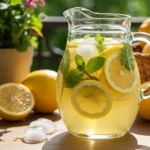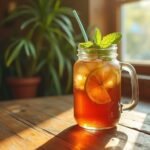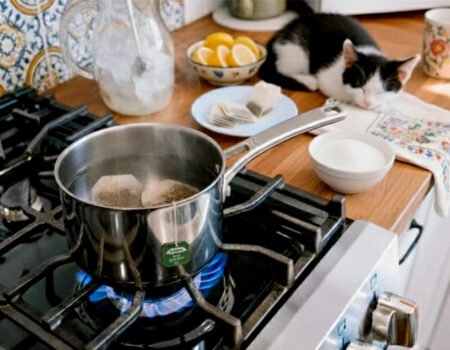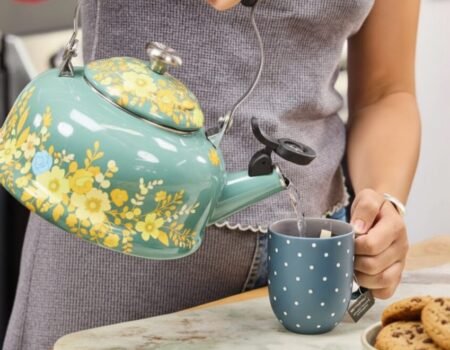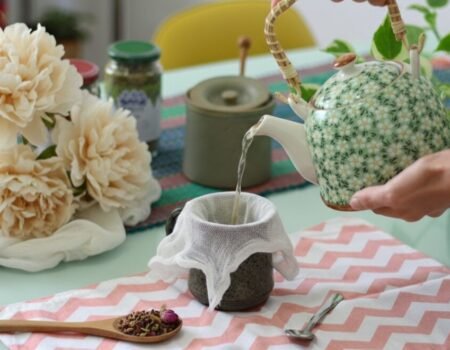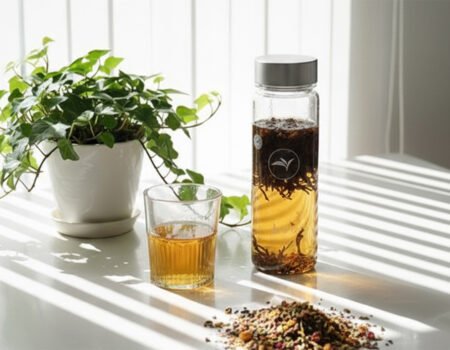
How to Make Chinese Restaurant Style Tea: Authentic Recipe
Index
In this guide, you’ll learn the exact steps to create that authentic Chinese restaurant tea experience at home. We’ll cover everything from selecting the right tea leaves to mastering the perfect steep time.
You’ll also discover which teapot works best and how to serve your tea properly. Get ready to impress your guests with tea that tastes just like the pros make it.
Key Takeaways
- Chinese restaurant tea typically uses jasmine, oolong, or pu-erh varieties, with proper water temperature being crucial (160°F for green tea, 210°F for black tea).
- Use 1 teaspoon of loose tea per 8 ounces of water, or about 10 tablespoons for a large 6-cup teapot that serves multiple guests.
- Steeping times vary by tea type: green tea needs 30 seconds to 3 minutes, black tea requires 3-5 minutes, and oolong can take 30 seconds to 10 minutes.
- Traditional clay teapots, especially Yixing purple clay pots, enhance flavor through heat retention and absorb tea essence over time.
- Proper serving includes pouring for guests first, moving clockwise, and tapping two fingers on the table to show thanks—a gesture from imperial times.
Understanding Chinese Restaurant Style Tea
Chinese restaurant tea stands out for its distinct brewing methods and leaf selection. The tea served at these eateries often reveals regional traditions and brewing secrets passed down through generations.
Common types of tea used

Jasmine tea stands as the most popular choice in many Chinese restaurants across America. This fragrant beverage combines green tea leaves with jasmine flowers to create a distinct floral scent that many diners recognize instantly.
Among premium jasmine varieties, Dragon Pearls (mo li hua zhu) offer an exceptional tea experience. These artfully hand-rolled balls of tender green tea leaves unfurl gracefully when steeped, creating a mesmerizing visual display in your cup. You’ll notice their distinctive appearance—uniform gray-green spheres covered with fine white pekoe hairs that gradually open into whole leaves.
Dragon Pearls deliver a delicate sweetness with pronounced jasmine aroma and fresh vegetal undertones. We find that these premium pearls can be steeped multiple times, revealing different flavor dimensions with each infusion. While not commonly served in casual establishments, high-end Chinese restaurants sometimes feature these elegant pearls as a specialty offering for discerning tea enthusiasts.
In the San Gabriel Valley area of Los Angeles, restaurants often serve simple teabag versions of jasmine tea. Oolong tea offers another common option with its partially oxidized leaves creating a balance between green and black tea flavors.
Several brands dominate the “Chinese Restaurant Tea” market, including Foojoy and Dynasty. The quality of tea served varies greatly by location and target customers.
Many establishments use inexpensive tea varieties like basic jasmine, oolong, or pu’erh tea. The tea selection often reflects regional preferences, with some areas favoring stronger brews while others prefer lighter, more delicate flavors.
The importance of tea quality

Tea quality makes all the difference in your cup. High-quality leaves produce richer flavors and can be brewed multiple times without losing their taste. Many tea drinkers don’t realize that premium tea is actually more cost-effective in the long run.
One ounce of quality oolong or keemun can yield several flavorful infusions, while cheaper alternatives often become flat and bitter after just one steep. Good tea shops let you sample before buying, helping you find the perfect match for your taste buds.
Water quality matters just as much as the tea itself. Fresh spring water brings out the best flavors in your tea, allowing proper extraction of the tea’s natural compounds. Tap water with chlorine or high mineral content can mask the subtle notes that make Chinese teas special.
The best Chinese restaurants pay close attention to both tea and water quality. They understand that proper brewing techniques combined with excellent tea leaves create that authentic experience their customers expect.
Testing different brews side by side is the most reliable way to spot truly superior tea.
What You Will Need
Getting the right tools makes all the difference in brewing authentic Chinese restaurant tea. You’ll need specific tea varieties and proper equipment to capture those rich flavors found in your favorite dining spots.
Tea leaves or bags

You can use either loose tea leaves or tea bags for authentic Chinese restaurant tea. High-quality loose leaves offer richer flavor and aroma, while tea bags provide convenience. For proper brewing, measure 1 teaspoon of loose tea for every 6 ounces of water, or about 4 tea bags for a standard pot.
Green tea varieties like Dragon Well (Longjing) or oolong teas such as Tie Guan Yin work best for that classic restaurant taste.
The quality of your tea matters greatly. Premium leaves will yield better flavor profiles with subtle notes that mass-produced bags might lack. Many Chinese restaurants use about 10 tablespoons of tea leaves for a large 6-cup (1.4L) teapot, which makes roughly 4½ cups after steeping.
This concentration creates that distinctive robust flavor found in authentic Chinese dining establishments.
Teapot and teaware essentials

Beyond selecting quality tea leaves, the right teapot makes a huge difference in your tea experience. Traditional Chinese tea service relies on specialized teapots that enhance flavor profiles.
Unglazed clay teapots from Yixing stand out as the gold standard, with their porous material absorbing tea essence over time. Purple Clay (Zisha) teapots offer superior heat retention and flavor enhancement, making them perfect for serious tea drinkers.
Teapot size matters based on how many people you’ll serve. A small #1 size (70 ml) works for 1-2 people, while larger gatherings might need a #4 size (225 ml) that serves 4-6 guests.
The shape affects flavor too – high-profile teapots bring out the best in green, white, and Pu-erh teas, while low-profile designs complement Tie Guan Yin, black teas, and Da Hong Pao varieties.
For the full Chinese restaurant experience, include a tea strainer, small cups, and a serving tray to create an authentic tea ceremony at home.
Step-by-Step Guide to Making Chinese Restaurant Style Tea

Making authentic Chinese restaurant tea requires simple steps that yield perfect results every time. Follow our clear guide to master the art of brewing this classic beverage with the right water temperature, steeping time, and serving techniques.
Preparing the tea leaves
Proper tea leaf preparation makes all the difference in creating authentic Chinese restaurant style tea. The right technique brings out the full flavor profile and creates that familiar taste you enjoy with dim sum or other Chinese cuisine.
- Select high-quality tea leaves based on your preference – oolong, jasmine, or pu’erh work well for Chinese restaurant style tea.
- Measure the correct amount of tea using a Chinese tea-scoop (about equal to one Western tablespoon).
- For a #2 size teapot, use 1.5-2 scoops of rolled leaves or 2.5-3 scoops of unrolled leaves.
- Rinse your tea leaves with hot water for 5-10 seconds to “awaken” them and remove any dust.
- Discard this first rinse water completely before starting the actual brewing process.
- Examine your tea leaves to determine their size classification – rolled leaves appear as small balls while unrolled leaves remain loose.
- Adjust your measurements based on leaf size – smaller leaves under 1 cm require less quantity than larger 2-4 cm leaves.
- Store unused tea leaves in an airtight container away from light, moisture, and strong odors.
- Consider the oxidation level of your tea as this affects steeping time – more oxidized teas like black tea can steep longer than green varieties.
- Tea leaves expand significantly during steeping, so avoid overfilling your teapot which prevents proper infusion.
Heating the water to the perfect temperature

Water temperature stands as the most vital factor in brewing perfect Chinese tea. Each tea type needs specific heat levels to release its best flavors without bitterness. Tea kettles work best for heating water precisely for your tea preparation.
- White and green teas need cooler water between 77-85°C (170-185°F) to avoid burning the delicate leaves.
- Black tea requires nearly boiling water at 99°C (210°F) to extract its full-bodied flavor profile.
- Oolong varieties need water between 85-100°C (185-212°F) depending on their oxidation level.
- Pu-erh tea demands fully boiling water at 100°C (212°F) to unlock its unique earthy qualities.
Chinese tea masters identify water temperature stages by bubble formation in the kettle. You’ll recognize “fish-eye water” by its large, slow bubbles rising to the surface – ideal for brewing stronger teas. “Crab-eye water,” displaying small streams of bubbles, makes it perfect for brewing delicate green teas. If you’re unsure about these visual cues, a food thermometer gives the most accurate reading.
Electric kettles with temperature settings offer convenience when brewing different tea types. When you need lower temperatures for delicate teas but only have boiling water, simply allow it to cool for 2-3 minutes. We’ve found that water quality significantly affects tea taste, so filtered water creates noticeably better results than standard tap water.
Traditional Chinese teapots hold heat remarkably well but may need pre-warming with hot water before use to maintain optimal brewing temperature. Tea shops in Chinatown often use special heating techniques passed down through generations, creating that authentic experience that many tea enthusiasts seek to recreate at home.
Steeping the tea for the right duration

Now that your water has reached the perfect temperature, the next crucial step is steeping your tea properly. The steeping time directly affects the flavor, strength, and overall quality of your Chinese restaurant style tea.
- Different tea types require specific steeping times. Green tea needs only 30 seconds to 3 minutes to avoid bitterness.
- Black tea should steep for 3 to 5 minutes to extract its full-bodied flavor and rich color.
- Oolong tea, popular in many Chinese restaurants, requires between 30 seconds to 10 minutes depending on the specific variety and your taste preferences.
- Pu’erh tea, known for its earthy qualities, needs 45 seconds to 10 minutes of steeping time.
- Rolled tea leaves follow a specific timing pattern. The first brew typically needs 10-15 seconds, with subsequent brews requiring less time.
- Unrolled tea leaves steep much faster. The first brew often needs just 1-2 seconds, gradually increasing with later infusions.
- Tea leaves expand during steeping, so your teapot should have enough space for this growth.
- A proper lid on the teapot traps heat and essential oils, creating a more flavorful brew.
- The tea’s color changes during steeping and serves as a visual indicator of readiness.
- Astringent flavors develop with longer steeping times, so adjust based on your preference for strength.
- Gongfu tea preparation uses shorter steeping times with multiple infusions to bring out different flavor notes.
- Many Chinese restaurants use large teapots and steep their tea longer for serving multiple guests.
- Tea shops in Hong Kong and Taiwan often provide specific steeping instructions for their unique blends.
- Quality tea leaves can be steeped multiple times, with each infusion revealing different flavor profiles.
How to Make Tea Like in a Hotel

Hotels often serve Chinese tea with a touch of elegance that you can recreate at home. Start with better quality tea leaves, such as oolongs or pu’erh, which many upscale establishments use.
Fill your teapot with 4 cups of cold water and bring it to the proper temperature (just below boiling for green tea). Add 4 teaspoons of loose tea leaves to your porcelain teapot, pour the hot water over them, and place the lid on top.
Let the tea steep for 3 to 5 minutes.
The secret to hotel-style tea lies in the presentation and serving method. Use a nice teacup or small cups similar to those in Chinese restaurants. Strain the tea as you pour it to catch any loose leaves.
Hotels often serve unsweetened tea, letting guests add sugar if desired. This simple process takes just 7 minutes from start to finish and creates a light, refreshing drink that pairs perfectly with Chinese food.
Many guests praise this style of tea for its clean taste and authentic flavor.
Tips for Enhancing the Tea Experience
Elevating your tea experience goes beyond brewing the perfect cup. Learn simple ways to make each sip more meaningful with proper serving methods and food pairings.
Proper serving techniques

Chinese tea service follows specific traditions that enhance the drinking experience. Pour tea into small cups using the Gong Fu Cha method, filling each cup only halfway to preserve heat and aroma.
The host should serve guests first as a sign of respect, moving clockwise around the table. Tap two fingers on the table to show thanks—a gesture dating back to imperial times. For formal settings, hold the teapot with your right hand and support its bottom with your left hand.
This prevents burns and shows proper care for the teaware.
Many tea experts suggest using a tea pitcher (called a gong dao bei) between your teapot and cups. This step ensures each cup receives tea of equal strength and flavor. The ideal serving temperature varies by tea type—oolong tastes best at 185-205°F, while green tea needs cooler temperatures around 170°F.
Match your serving style to your tea choice for the most authentic flavor profile. Quality yixing teapots with proper spout sizes allow smooth pouring without dripping, making the serving process both practical and elegant.
Pairing tea with Chinese dishes

Tea and food pairing enhances your dining experience at any Chinese restaurant. Green tea works best with seafood dishes and light dim sum because its fresh flavor doesn’t overpower delicate foods.
Oolong tea stands up beautifully to roasted meats and spicy foods, with its complex profile cutting through rich flavors. For fatty dishes, try pu-erh tea, as its earthy notes help break down heavy meals and cleanse the palate.
Black tea pairs perfectly with red meat dishes and dark chocolate desserts due to its robust character. White tea offers a subtle match for light chicken dishes, fresh fruits, and soft cheeses served as appetizers.
The right tea can transform your meal from good to great by balancing flavors and aiding digestion. Many local Chinese restaurants offer specific tea blends designed to complement their signature dishes.
You might notice servers pour the tea throughout your meal to maintain ideal temperature and flavor. Tea masters in Taiwan and Malaysia have developed special brewing methods that bring out unique flavors to match regional cuisines.
Next, we’ll explore some expert tips for creating the perfect tea experience at home.
Conclusion

Making Chinese restaurant style tea at home brings authentic flavors to your dining table. The right leaves, proper water temperature, and correct steeping time create that perfect cup you enjoy after meals.
Your guests will notice the difference between regular tea and this special brew. Practice makes perfect, so don’t worry if your first attempts aren’t restaurant-quality. Soon you’ll master this simple yet refined skill, turning ordinary moments into mini tea ceremonies right in your kitchen.
FAQs
1. What type of tea is used in Chinese restaurants?
Most Chinese restaurants serve jasmine and oolong tea, though some may use black tea (hongcha) or pu’erh. The tea choice often depends on the restaurant’s regional focus, with Taiwanese teas being popular in many United States establishments.
2. How do I properly infuse Chinese tea?
Fill the teapot with tea leaves (about one teaspoon per cup), then add boiling water and let it steep for 3-5 minutes. Don’t let the leaves steep too quickly or your tea will taste bitter.
3. Can I make sweet tea in the Chinese style?
Yes! After brewing your Chinese tea, add sugar while it’s hot. For extra flavour, try adding lemon or orange slices like they do in some modern Chinese teashops.
4. What is the difference between Chinese tea and Japanese tea?
Chinese tea focuses on the natural flavours of the leaves through methods like gong-fu cha, while Japanese tea ceremony (cha no yu) emphasizes ritual and precision. Chinese teas include oolong and lapsang souchong, while Japanese teas are often steamed green varieties.
5. How can I make bubble tea at home?
Brew strong black tea or oolong, then cool it. Add milk, sugar, and cooked tapioca pearls. This Taiwanese drink has become popular in Chinese restaurants across America.
6. Should I use loose leaves or tea bags for authentic Chinese restaurant tea?
Always use loose leaves for authentic Chinese restaurant tea. Lipton tea bags won’t give you the complex flavours found in traditional Chinese or Formosa teas. James Norwood Pratt, a tea expert, suggests visiting Chinese tea shops to find quality loose leaves for the best results.
References
- https://orientaleaf.com/blogs/tea-101/the-secret-of-chinese-restaurant-tea?srsltid=AfmBOoqcQjmoyRdCAmCR-0tQbeGCd3T6lbGtqaF8laSW6zdK4qkGIszB
- https://thechineseteashop.com/pages/gong-fu-cha-the-complete-guide-to-making-chinese-tea
- https://www.food.com/recipe/chinese-green-tea-438162
- https://www.seriouseats.com/tea-brewing-equipment
- https://zhentea.ca/how-to-brew-chinese-tea-water-temperature/?srsltid=AfmBOoo7N9k0tsF0-jea8wdA4GNgSsKBdpUgzgdVf4xxEcQejhXeYpN4
- https://jyyna.co.uk/how-do-you-make-chinese-tea/
- https://www.essenceoflife-food.com/2020/01/how-to-make-chinese-tea.html
- https://www.teasenz.com/chinese-tea/category/how-to-make-tea.html?srsltid=AfmBOor_E2Jrd3E2elEtc_xk-HlOcefkm7BRoLooB2UvJIKsE4vaDlVP
- https://www.redrockteahouse.com/blogs/articles/tea-pairing?srsltid=AfmBOorLrVt_siizao3WHQ6q6RIA615-Vfd4KpVS5NnHbtKvF9ooNVSx

